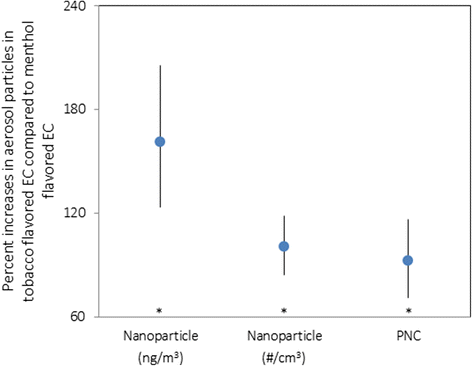Nicotine, aerosol particles, carbonyls and volatile organic compounds in tobacco- and menthol-flavored e-cigarettes
- PMID: 28449666
- PMCID: PMC5406907
- DOI: 10.1186/s12940-017-0249-x
Nicotine, aerosol particles, carbonyls and volatile organic compounds in tobacco- and menthol-flavored e-cigarettes
Abstract
Background: We aimed to assess the content of electronic cigarette (EC) emissions for five groups of potentially toxic compounds that are known to be present in tobacco smoke: nicotine, particles, carbonyls, volatile organic compounds (VOCs), and trace elements by flavor and puffing time.
Methods: We used ECs containing a common nicotine strength (1.8%) and the most popular flavors, tobacco and menthol. An automatic multiple smoking machine was used to generate EC aerosols under controlled conditions. Using a dilution chamber, we targeted nicotine concentrations similar to that of exposure in a general indoor environment. The selected toxic compounds were extracted from EC aerosols into a solid or liquid phase and analyzed with chromatographic and spectroscopic methods.
Results: We found that EC aerosols contained toxic compounds including nicotine, fine and nanoparticles, carbonyls, and some toxic VOCs such as benzene and toluene. Higher mass and number concentrations of aerosol particles were generated from tobacco-flavored ECs than from menthol-flavored ECs.
Conclusion: We found that diluted machine-generated EC aerosols contain some pollutants. These findings are limited by the small number of ECs tested and the conditions of testing. More comprehensive research on EC exposure extending to more brands and flavor compounds is warranted.
Keywords: Carbonyls; Nicotine; Particles; VOCs in e-cigarette emissions.
Figures
References
Publication types
MeSH terms
Substances
Grants and funding
LinkOut - more resources
Full Text Sources
Other Literature Sources
Medical



